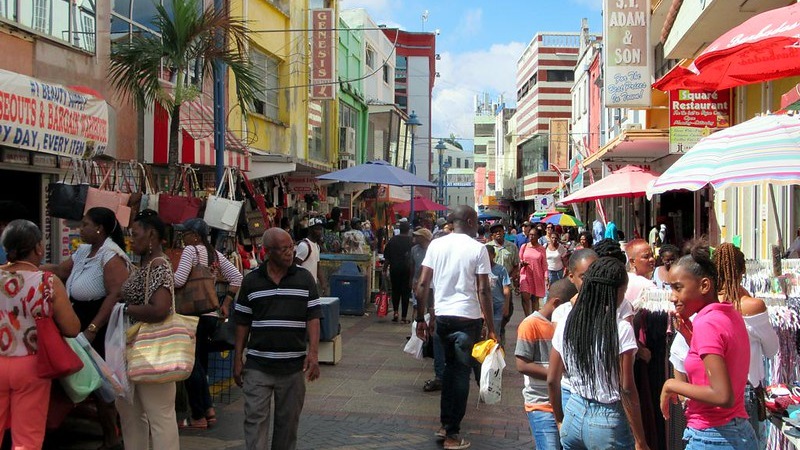The Caribbean nation of Barbados is pursuing what a key official called the “Norwegian model” by exporting oil and gas while cleaning up its own cars and electricity production.
The government recently submitted plans to the UN to make 100% of its cars run on electricity or alternative fuels and to get 95% of its electricity from renewable sources by 2030.
“Our vision is that by 2030 most Barbadian homes will have solar PV panels on their roofs and an electric vehicle in their garage,” prime minister Mia Mottley said in December.
At the same time, the government is supporting two oil and gas exploration schemes in its Caribbean waters. One is with Australian company BHP and the other is with the government of Trinidad and Tobago.
Climate envoy Hugh Sealy said the government planned to support oil and gas production but not use it domestically. He called this the “Norwegian model”. “If we find oil and gas offshore, we can’t ignore it but it cannot be used in our domestic economy,” he said.
Barbados’s updated climate plan aims to reduce the island state’s emissions, relative to a business as usual projection, 35% by 2030. This rises to 70% if it gets financial support from other countries.

Barbados’s projected emissions. Business as usual is in red. Its conditional target is in green (Photo: Government of Barbados/Screenshot)
On the international stage, Mottley has led calls for green debt relief and received a prominent billing at the UK’s December 2020 climate ambition summit, speaking ahead of India’s Narendra Modi and the Pope.
The plan involves pivoting rapidly from oil for power generation to rooftop solar and wind with battery storage. As of 2015, over 90% of Barbados’s electricity came from imported oil and World Bank data shows the price of electricity is 60% higher than the global average.
As well as the climate benefits, reducing reliance on oil imports has financial benefits, Sealy said. In an island exposed to hurricanes, rooftop solar power is more resilient than centralised generation distributed through power lines, which can be knocked over by strong winds.
Displaced Afghan negotiator calls for climate aid to war-torn states
The government hopes to launch a revolving fund, through which Barbadians are loaned the money for rooftop solar panels and pay back the government from the savings on their energy bill.
Sealy said that this pace of transition involved a cost premium of up to 30% compared to a natural progression towards renewable energy. “But we’re prepared to pay that cost premium because we recognise this something that we have to do.”
It would not necessarily lead to higher bills for consumers, he said, as that depended on oil price fluctuations, the pace of renewable cost reductions and sale of carbon credits.

Hurricane Laura takes down power lines in Louisiana in 2020. (Photo: Julie Dermansky/Greenpeace)
As solar and wind energy are variable, energy experts have debated whether they can be relied on to provide 100% of a country’s energy.
Sealy said: “You can’t have an unreliable electricity sector… no tourist is going to want to come to an island where the air conditioning cuts out all the time.”
But he said that that grid operator Emera had worked with North American consultants on its energy plan and found that it was technically feasible.
On vehicles, Barbados’s plans are one of the most ambitious in the world. They plan to make all passenger vehicles run on electricity or alternative fuels by 2030.
This is arguably more ambitious than the plans of countries in Europe or North America, which have pledged only to ban new sales of internal combustion engine (ICE) cars by a given date between 2030 and 2040.
Conservationists set out ‘nature positive’ vision for global biodiversity deal
Sealy said that if Barbados banned ICE sales today, the lifetime of vehicles means around 30% of the vehicles on the roads in 2030 would still be ICE.
So, while this transition from ICE to electric vehicles takes place, he said that ICE vehicles will have to run partly on ethanol, biodiesel and biogas.
Julius Adiatma, biofuel researcher at Indonesian think tank IESR, told Climate Home News that, without modifying an ICE, they can only use between 10% and 30% ethanol or biodiesel. The rest of the fuel must be traditional fuels like petrol.
Altering vehicles so they can run just on ethanol would be a “new investment that will take some time to pay back,” he added. “This may slow down the rate of electric vehicle sales, as people will probably wait for another 10+ years after their investment before switching to electric vehicles.”
Francis Johnson, Stockholm Environment Institute researcher on biofuels, said Barbados can make fuel from homegrown crops like sugarcane.
Around the world, electric vehicle uptake is often hindered by a lack of charging facilities and “range anxiety”. But Barbados is so small, Sealy said, that you can go around three times with one battery charge.
